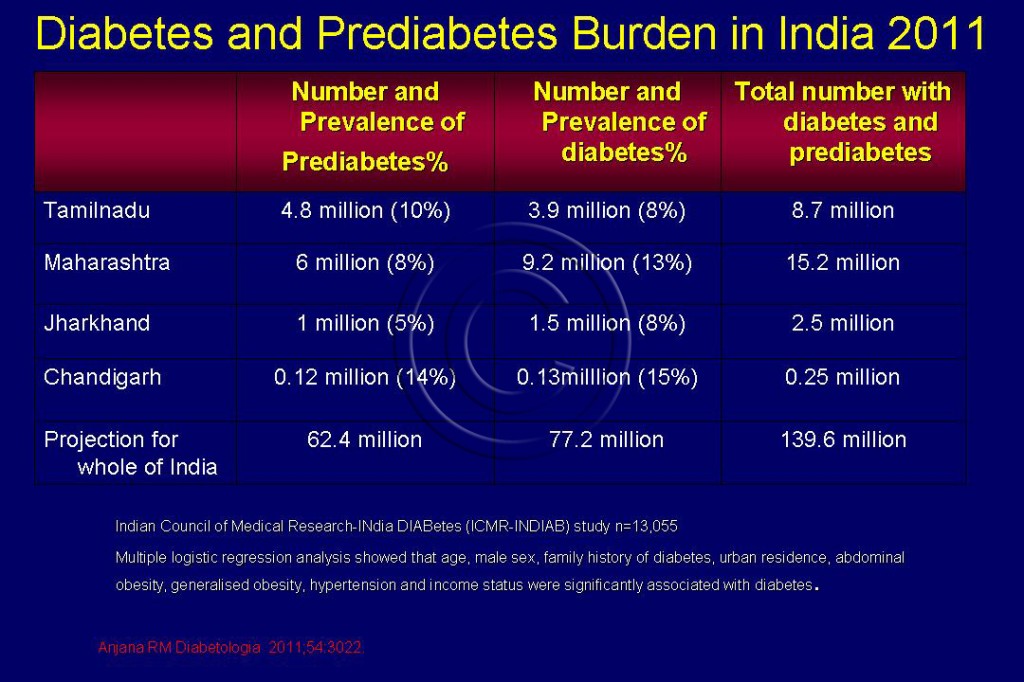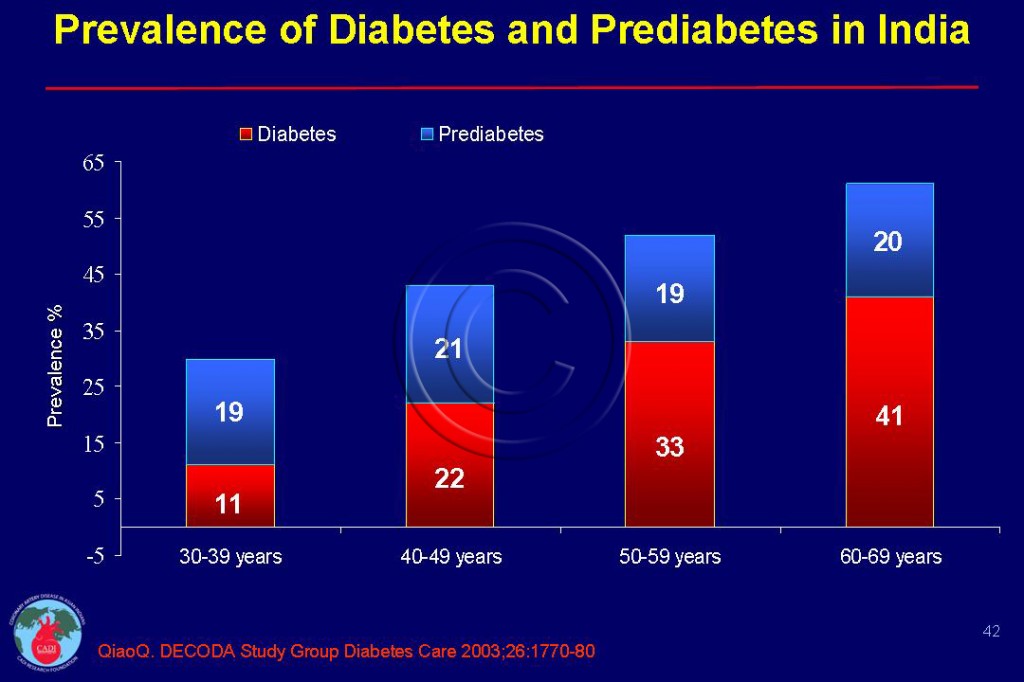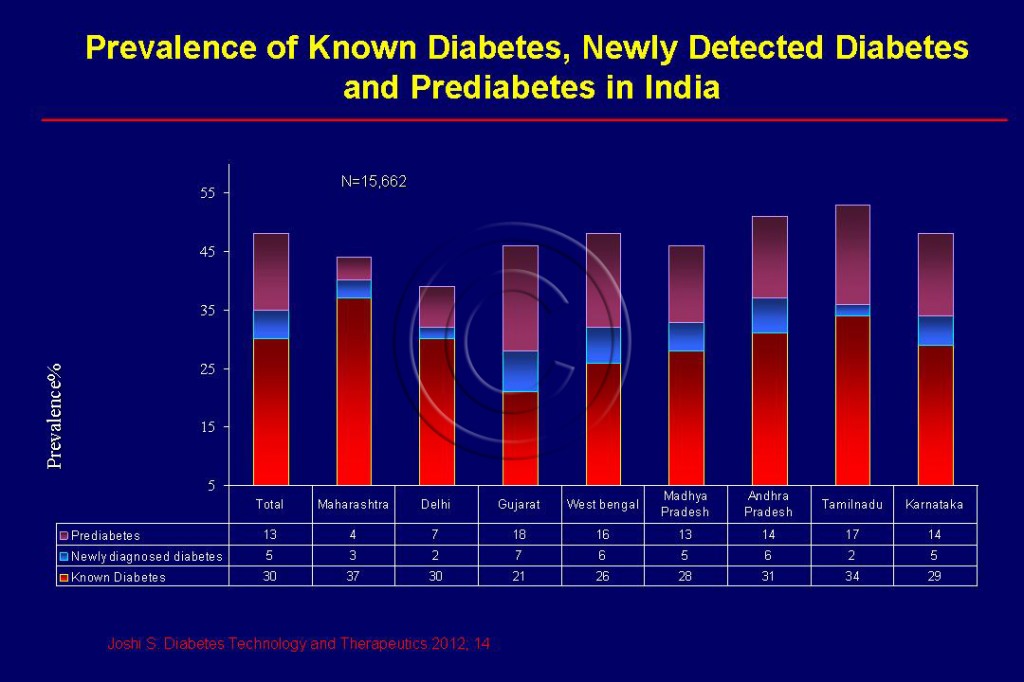Diabetes Epidemic in India
- India is facing a twin burden of under-nutrition and over-nutrition: it figures prominently both in the hunger map of the world as well as being the diabetes capital of the world.1 A country experiencing rapid socioeconomic progress and urbanization, India carries the highest burden of diabetes with escalating prevalence in both urban and rural populations. 2
- India is facing an epidemic of diabetes, with high prevalence in urban areas. Over the past 30 years, the prevalence of diabetes has increased to 12-18% in urban India and 3-6% in rural India with significant regional variations.1, 3, 4 5, 6 These rates in India are 50-80% higher than China (10%).
- Another 14% having prediabetes ─a harbinger of future diabetes─ is as high as diabetes in Indians.1, 2
- The difference in prevalence of diabetes across India could be due to dissimilar levels of urbanization and lifestyle factors such as different diets and varying obesity levels.7, 8
- Significant determinants of diabetes are age, body-mass index (BMI), waist-hip ratio, low physical activity, and family history of diabetes. The driving forces behind the epidemic are urbanization (30%) and economic development with resultant increase in GDP, sedentary lifestyle, western diet, and fast food diet on a background of genetic susceptibility.
- The prevalence of both diabetes and prediabetes increases by age with 60% of Indians having diabetes or prediabetes by age 60 (Figure 042 & Table 34).9
- While some genes confer increased susceptibility to diabetes among Indians, other genes that are protective in Europeans do not appear to protect Indians.10-12
- Indians develop diabetes at a younger age and those younger than 45 years accounts for 36% of all diabetics in India.13 Longer duration of diabetes leads to greater complications and this could threaten the national economy.
- Given that 80%of diabetics will die from cardiovascular disease (CVD), the medical and socioeconomic costs will be insurmountable unless urgent steps are taken to prevent or ameliorate the CVD complications which are higher among Indians than other populations (see Diabetes and CVD).14
- CVD risk is primarily due to elevated lipids and blood pressure (much more than elevated blood sugar). Unfortunately, management of blood pressure and cholesterol remains dismally poor among diabetics in India (see Diabetes Control).
- The latest data (2012) shows a prevalence of diabetes in excess of 25% in most states as shown in the figure 108.
- The major challenge is to translate current knowledge into prevention programs throughout the community and the country.15
Sources
1. Mohan V, Sandeep S, Deepa R, Shah B, Varghese C. Epidemiology of type 2 diabetes: Indian scenario. Indian J Med Res. Mar 2007;125(3):217-230.
2. Ramachandran A, Snehalatha C. Current scenario of diabetes in India. J Diabetes. Mar 2009;1(1):18-28.
3. Ramachandran A, Mary S, Yamuna A, Murugesan N, Snehalatha C. High prevalence of diabetes and cardiovascular risk factors associated with urbanization in India. Diabetes Care. May 2008;31(5):893-898.
4. Reddy KS, Prabhakaran D, Chaturvedi V, et al. Methods for establishing a surveillance system for cardiovascular diseases in Indian industrial populations. Bull World Health Organ. Jun 2006;84(6):461-469.
5. Abate N, Chandalia M. Ethnicity and type 2 diabetes: focus on Asian Indians. Journal of diabetes and its complications. Nov-Dec 2001;15(6):320-327.
6. Ramachandran A, Sathyamurthy I, Snehalatha C, et al. Risk variables for coronary artery disease in Asian Indians. Am J Cardiol. 2001;87(3):267-271.
7. Reddy N K, Kumar DN, Rayudu NV, Sastry BK, Raju BS. Prevalence of risk factors for coronary atherosclerosis in a cross-sectional population of Andhra Pradesh. Indian heart journal. Nov-Dec 2002;54(6):697-701.
8. Ramachandran A, Snehalatha C, Kapur A, et al. High prevalence of diabetes and impaired glucose tolerance in India: National Urban Diabetes Survey. Diabetologia. 2001;44(9):1094-1101.
9. Qiao Q, Hu G, Tuomilehto J, et al. Age- and sex-specific prevalence of diabetes and impaired glucose regulation in 11 Asian cohorts. Diabetes Care. Jun 2003;26(6):1770-1780.
10. Abate N, Chandalia M, Satija P, et al. ENPP1/PC-1 K121Q polymorphism and genetic susceptibility to type 2 diabetes. Diabetes. Apr 2005;54(4):1207-1213.
11. Vimaleswaran KS, Radha V, Ghosh S, et al. Peroxisome proliferator-activated receptor-gamma co-activator-1alpha (PGC-1alpha) gene polymorphisms and their relationship to Type 2 diabetes in Asian Indians. Diabet Med. Nov 2005;22(11):1516-1521.
12. Radha V, Vimaleswaran KS, Babu HN, et al. Role of genetic polymorphism peroxisome proliferator-activated receptor-gamma2 Pro12Ala on ethnic susceptibility to diabetes in South-Asian and Caucasian subjects: Evidence for heterogeneity. Diabetes Care. May 2006;29(5):1046-1051.
13. Ramachandran A, Ma RC, Snehalatha C. Diabetes in Asia. Lancet. Jan 30 2010;375(9712):408-418.
14. Mohan V, Shanthirani CS, Deepa M, Deepa R, Unnikrishnan RI, Datta M. Mortality rates due to diabetes in a selected urban south Indian population–the Chennai Urban Population Study [CUPS–16]. J Assoc Physicians India. Feb 2006;54:113-117.
15. Ramachandran A, Snehalatha C. Diabetes prevention programs. Med Clin North Am. Mar 2011;95(2):353-372.




